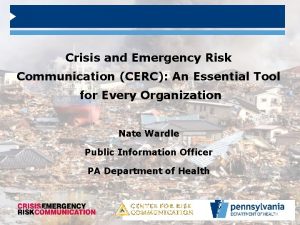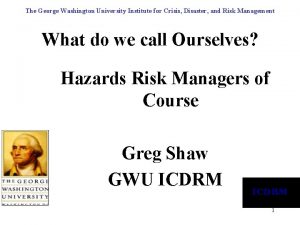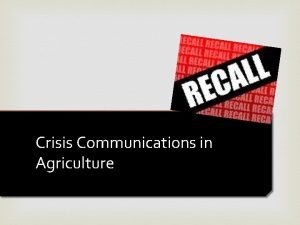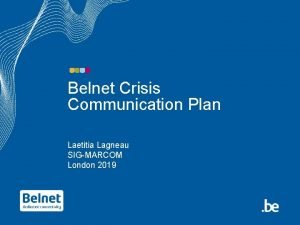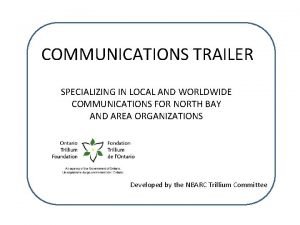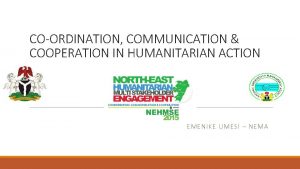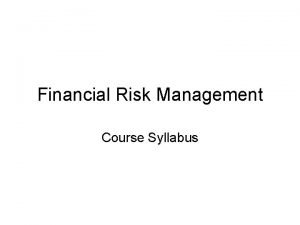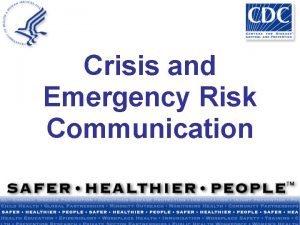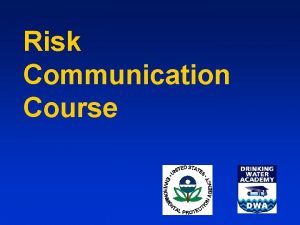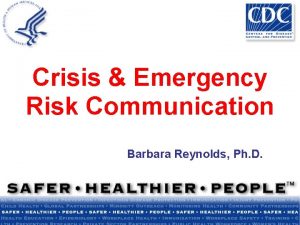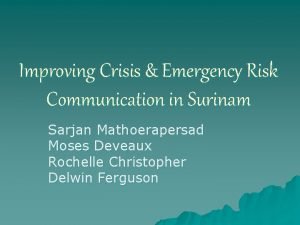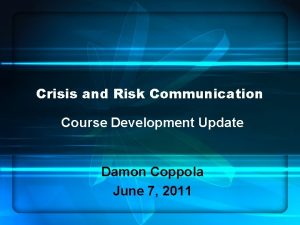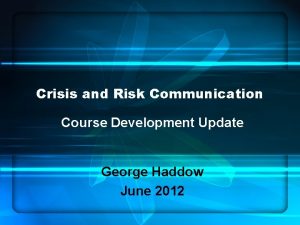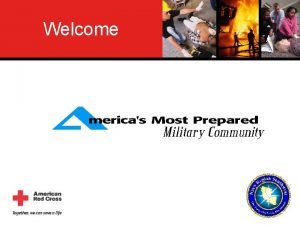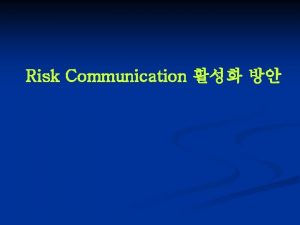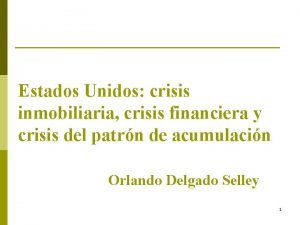Crisis and Emergency Risk Communication Course Overview Welcome























- Slides: 23

Crisis and Emergency Risk Communication

Course Overview

• Welcome • Crisis and emergency risk communication – Training to help people cope, empower decisionmaking, and begin to rebuild a sense of normalcy in their lives • Training agenda • Purpose and learning objectives • Conceptual overview

Training Agenda DAY ONE • • • DAY TWO Course Overview • Case Study Psychology of a Crisis • Working with the Media AAudiences 1 ½-day interactive, Messages and • Stakeholder/Partner Communication Crisis Communication Plan participatory training • Spokesperson Terrorism and Bioterrorism on crisis and emergency Communication Challenges risk communication • Risk Communication Assessment • Setup for Case Study

Purpose • Emergency risk communication can help people cope, make risk/benefit decisions, and begin to return their lives to normal. • Attempt to provide the public with information to make the best possible decisions within nearly impossible time constraints and to accept the imperfect nature of choice.

Learning Objectives • Explain the psychology of a crisis and its impact • Provide you with core planning tools to prepare for and respond to the communication challenges that occur in times of crisis

Conceptual Overview There is: • Crisis communication • Issue(s) management communication • Risk communication • Crisis and emergency risk communication Each has its own pressures. You must be familiar and prepared to deal with all of them.

Conceptual Overview Communicator: Participant There is: Time Pressure: Urgent and unexpected Message Purpose: Explain and persuade • Crisis communication • Issue(s) management communication • Risk communication • Crisis and emergency risk communication Each has its own pressures. You must be familiar and prepared to deal with all of them.

Conceptual Overview Communicator: Participant There is: Time Pressure: Anticipated Message Purpose: Explain and persuade • Crisis communication • Issue(s) management communication • Risk communication • Crisis and emergency risk communication Each has its own pressures. You must be familiar and prepared to deal with all of them.

Conceptual Overview Communicator: Nonparticipant, neutral about There is: outcome Time Pressure: Anticipated, no time pressure • Crisis communication Message Purpose: Empower decisionmaking • Issue(s) management communication • Risk communication • Crisis and emergency risk communication Each has its own pressures. You must be familiar and prepared to deal with all of them.

Conceptual Overview Communicator: After-event participant, There is: invested in outcome Time Pressure: Urgent and unexpected • Crisis communication Message Purpose: Explain, persuade, and empower decisionmaking • Issue(s) management communication • Risk communication • Crisis and emergency risk communication Each has its own pressures. You must be familiar and prepared to deal with all of them.

Crisis Communication Lifecycle Precrisis • Prepare • Foster alliances • Develop consensus recommendati ons • Test message • Evaluate plans Initial • Express empathy • Provide simple risk explanations • Establish credibility • Recommend actions • Commit to stakeholders Maintenance • Further explain risk by population groups • Provide more background • Gain support for response • Empower risk/benefit decisionmaking • Capture feedback for analysis Resolution • Educate a primed public for future crises • Examine problems • Gain support for policy and resources • Promote your organization’s role Evaluation • Capture lessons learned • Develop an event SWOT • Improve plan • Return to precrisis planning

Precrisis Phase • • • Prepare Foster alliances Develop consensus recommendations Test message Evaluate plans

Initial Phase • • • Express empathy Provide simple risk explanations Establish credibility Recommend actions Commit to stakeholders

Maintenance • • • Further explain risk by population groups Provide more background Gain support for response Empower risk/benefit decisionmaking Capture feedback for analysis

Resolution • • Educate “primed” public for future crises Examine problems Gain support for policy and resources Promote your organization’s role

Evaluation • • Capture lessons learned Develop an event SWOT Improve plan Return to precrisis planning

The Risk of Disasters Is Increasing • • • Increased terrorism Population density Aging U. S. population International travel speed Emerging diseases

Role of Crisis and Emergency Risk Communication Customer Focus • Gain wanted facts • Empower decisionmaking • Involve as a participant, not spectator • Take feedback to responders • Provide watchguard resource allocation • Recover or preserve well-being and normalcy

Role of Crisis and Emergency Risk Communication Organizational Focus • Execute response and recovery efforts • Gain support for crisis management plans • Avoid misallocation of limited resources • Ensure that decision-makers are well-informed • Reduce rumors • Decrease illness, injury, and deaths • Avoid wasting resources

Contributors to a Poor Public Response to Recovery Plans • • • Mixed messages from multiple experts Information released late Paternalistic attitudes No reality check on recommendations Not countering rumors and myths in real-time Public power struggles and confusion

Formula To Meet Customer and Organization Goals • • Executed solid communication plan Be the first source for information Express empathy early Show competence and expertise Remain honest and open Remain dedicated to customer long term Apply emergency risk communication principles

Emergency Risk Communication Is a Valid Tool • Not mass mental therapy • Mature approach to the selection of message, messenger, and method of delivery
 Crisis and emergency risk communication
Crisis and emergency risk communication Liquidity measures
Liquidity measures Myasthenic crisis vs cholinergic crisis ppt
Myasthenic crisis vs cholinergic crisis ppt Institute for crisis disaster and risk management
Institute for crisis disaster and risk management Crisis text line ladder up risk assessment
Crisis text line ladder up risk assessment Course number and title
Course number and title Welcome welcome this is our christmas story
Welcome welcome this is our christmas story Dear students,
Dear students, Crisis communication working group
Crisis communication working group Crisis communications lecture
Crisis communications lecture Crisis communication plan
Crisis communication plan Crisis communication skills
Crisis communication skills Public response
Public response T junction in english bond
T junction in english bond Course interne course externe
Course interne course externe Residual risk and secondary risk pmp
Residual risk and secondary risk pmp Business risk and financial risk leverage
Business risk and financial risk leverage Relative risk and attributable risk
Relative risk and attributable risk Parirt
Parirt Emergency communication trailer
Emergency communication trailer Communication coordination cooperation during the emergency
Communication coordination cooperation during the emergency Certification course in risk management nibm
Certification course in risk management nibm Financial risk manager syllabus
Financial risk manager syllabus What is risk projection in software engineering
What is risk projection in software engineering
